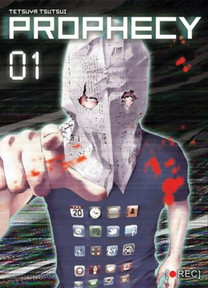Review
by Rebecca Silverman,Prophecy
GN 1
| Synopsis: |  |
||
With the rise of the Internet, crimes have taken on a new aspect. Now there are cyber crimes...and those appear to be carrying over into the real world. Now a man calling himself “Paperboy” is posting videos describing people who have done wrong and the justice he will mete out to them. His vengeance seems to be escalating, and conflicting accounts of his physical appearance suggest that there may be a more than one of him...and the Internet community loves him more all the time. Can the special police task force take him down? And will that really solve the problem – or will it just set the country against them? |
|||
| Review: | |||
Have you ever dreamed of vengeance? Not just silly little things, but honest-to-goodness revenge against someone who did the unspeakable to you or someone you care about? Even if you have, or have read other manga about similar themes, there's something kind of chilling about the first volume of Tetsuya Tsutsui's three volume series Prophecy. Tsutsui's story looks at how the Internet has changed social behavior and what anonymity can do to and for a person. It is a fascinating and at the same time frightening look at net trolls taking the fight into the real world, and even as a piece of you condemns Paperboy for his actions, another part sort of admires his work. It's the old vigilante conundrum brought into a very present day, and Prophecy really is hard to put down. From the beginning Tsutsui sets the story up to cause its readers a conflicting sense of loyalty. On May 21st in Tochigi Prefecture, a middle school student is being prosecuted for uploading ripped games to the Internet. The cops in charge of his case are Anti Cyber Crimes Division of the Metropolitan Police, a special group led by Erika Yoshino, a singularly unpleasant young woman. While the child's behavior is reprehensible – it's a blatant act of piracy – Yoshino's treatment of him is just as bad, telling him that she'd “like to beat [him] until...[he] got straightened out” while physically harming him. (He's bleeding when she leaves.) This sets up a problem for the reader: do we sympathize with the police, who are responding to a legitimate complaint from a wronged party, or do we instead give our sympathies to the child, who is clearly without much parental guidance and may not have fully understood the significance of his actions? It is a conundrum that the book tries its best not to provide an answer to, even as the crimes get more violent and the perpetrators older and more responsible for their actions. The main crimes in the book are attributed to someone calling himself “Paperboy.” Each time he records a new video he wears a mask made of that day's newspaper over his face, possibly as some sort of time stamp. His targets are always people who bragged about online crimes, such as a man who said that a rape victim was asking for it or a potential employer who posted mean comments about an older man trying to get an entry-level job. These, Paperboy seems to feel, are crimes that the police cannot prosecute, so he will stand up for the oppressed instead. And yes, what these people did is horrible – but they are essentially thought crimes, and Paperboy's persecution of them is tantamount to punishing them for their words rather than any deeds. On the other hand, it's hard to argue that they aren't horrible people, or at the very least criminally insensitive...just part of how Prophecy keeps us off-balance with each new chapter. Tsutsui also employs an element of Agatha Christie's Murder on the Orient Express in terms of how crimes are carried out, keeping the police in a state of confusion that does next to nothing for their likability or to sort out our feelings for them, and watching them grapple with their confusion at the crimes as well as the way the public increasingly backs Paperboy while turning against them is mesmerizing. The art in Prophecy is much more realistic than most of the other English-language manga on the shelves, featuring different body types and a lack of many of manga's visual tropes. It also uses a lot of real brand names in its artwork, although “YouTube” is changed to “YourTube” about halfway through the book and “Niconico” is changed to “Niccori.” Facebook, interestingly, is the only company whose real name is never used (“Facedock”), while Google remains Google throughout. All of this is worth noting if only because right there on the cover are the actual Facebook and Twitter icons, along with Skype and others. Prophecy's first volume is an exercise in trying to pick a side while getting pulled into an increasingly engaging story about crime in the digital age. No one comes out looking particularly good, but no one is especially bad either, and honestly Yoshino is the least likable character – and she's the ostensible good guy. It feels like a timely book, but more than that it's a good one and one that keeps you thinking throughout. |
| Grade: | |||
|
Overall : A-
Story : A-
Art : B+
+ Timely, interesting story that keeps you off-balance. More realistic art helps ground the story. |
|||
| discuss this in the forum (8 posts) | | |||
| Production Info: | ||
|
Full encyclopedia details about Release information about |
||